parody
The World Still Says No to War
 Those little blue stickers are popping on the streets of New York again. This Saturday, on the one-year anniversary of the invasion of Iraq, millions will take to the streets to call for peace. Protests are scheduled in over 50 countries, with over 200 events planned around the United States.
Those little blue stickers are popping on the streets of New York again. This Saturday, on the one-year anniversary of the invasion of Iraq, millions will take to the streets to call for peace. Protests are scheduled in over 50 countries, with over 200 events planned around the United States.
United for Peace and Justice has made variations on their “flag” flyer template available for download with space to add details about your local event or create your own translation, and with rotated globes for events in Africa, Asia, or Europe.
By now there are plenty of downloadable flyers on the Web, but few designed for translation and personalization, while retaining a generally persistent brand. I’ve not seen another organization producing anti-war posters this user-oriented.
Except the Bush-Cheney presidential campaign.
From Wired:
“The Bush-Cheney presidential campaign disabled features of a tool on its website Thursday that pranksters were using to mock the Republican presidential ticket.
The tool originally let users generate a full-size campaign poster in PDF format, customized with a short slogan of their choice. But Bush critics began using the site to place their own snarky political messages above a Bush-Cheney ’04 logo and a disclaimer stating that the poster was paid for by Bush-Cheney ’04, Inc.”
See a handful of sample posters in this nostalgic Fash piece.
Uncle Sam
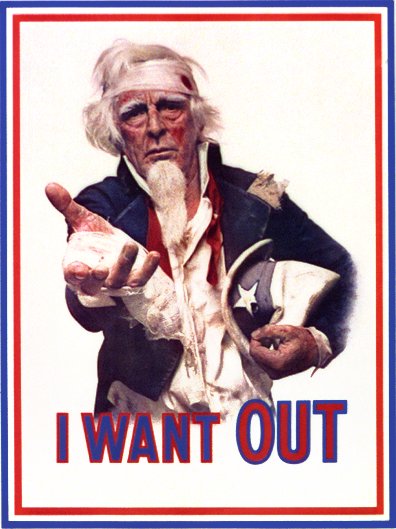
From the Committee to Help Unsell the War, 1971.
Download the image above as a 782 x 1024 pixel TIFF (2.3 Mb) from the Library of Congress.
A Game of Hearts
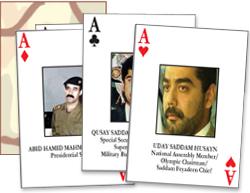 On April 11, 2003 the U.S. military released their list of most-wanted senior Iraqi government in the form of a deck of playing cards.
On April 11, 2003 the U.S. military released their list of most-wanted senior Iraqi government in the form of a deck of playing cards.
The cards were designed by staff of the Defense Intelligence Agency and the 3401st and 3418th Military Intelligence Detachments. One of the designers, Sergeant Scott Boehmler, 27, an Army reservist from Hazleton, Pennsylvania reports, “We understood what guys like to do on their downtime. This is an effective way of getting these images in the soldiers’ minds.”
Images can be downloaded from the Department of Defense Web site in HTML or PDF.
Production of the cards was widely covered in the U.S. mainstream media and treated as a significant event in the war. Subsequent reports of the arrest of Iraqi officials frequently refer to the list, even noting when an arrested official is not on the list. The reports are occasionally illustrated with an image of said official’s playing card.
The decks have also become enormously popular with the public. Web sites have sold hundreds of thousands of decks. As of May, one company reported $1.5 million in sales. It’s one thing to sell a war to the public. It’s whole other matter for them to buy it themselves in droves. I’ve even seen street vendors in NYC selling the decks alongside the knockoff sun glasses and watches and received a couple of unsolicited email messages offering the decks for sale.
U.S. military personnel are the world’s largest consumers of playing cards, according to Cincinnati-based United States Playing Card Company, the world’s largest playing card manufacturer. According to Time (May 12, 2003) the extreme popularity of the most-wanted cards prompted the distributor to reissue cards created for the military in earlier wars. During World War II “spotter decks” were produced for troops to distinguish between Allied and enemy aircraft. During the Vietnam War “decks containing only the ace of spades were passed out to U.S. troops, who would display a card on their helmets to scare away the Viet Cong — supposedly superstitious about the card, which fortune tellers considered a harbinger of suffering and death.”
The cards have inspired a genre of spinoffs.
GreatUSAflags.com has followed up with U.S. Military Heroes playing cards “honoring America’s servicemen and women involved in Operation Iraqi Freedom.” The deck also features images of aircraft, ships, submarines, aircraft carriers, vehicles and missiles deployed in battle.
On April 25, global justice group, the “Trade Regulation Organization,” released their U.S. Regime Change cards [image, PDF 6MB]. The group, “estimating that the U.S. governing regime is no longer consistent with world peace or prosperity, hopes that the playing cards will show the way to regime change and, eventually, large-scale war crimes proceedings.”
On May 1, Greenpeace International released a deck of “most wanted” cards depicting the nuclear powers of the world. [PDF, 96K] “This deck is designed to help delegates to the Non-proliferation Treaty meeting recognise owners of weapons of mass destruction. Packed with nuclear weapons of mass destruction facts. Fun for the whole family.” Says Tom Clements, senior campaigner with Greenpeace, “It ties the anti-war message together with the disarmament message.”
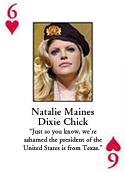 On May 7, the conservative Web site NewsMax announced the Deck of Weasels [image] which features images of anti-war celebrities and politicians includes Michael Moore, Tim Robbins, Jacques Chirac, Barbara Streisand, Teddy Kennedy, Kofi Annan, Vicente Fox, Jean Chretien,
On May 7, the conservative Web site NewsMax announced the Deck of Weasels [image] which features images of anti-war celebrities and politicians includes Michael Moore, Tim Robbins, Jacques Chirac, Barbara Streisand, Teddy Kennedy, Kofi Annan, Vicente Fox, Jean Chretien, 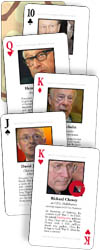 Senator Ted Kennedy and Robert Byrd. Each card features a quote by the celeb opposing the U.S. invasion of Iraq. Each of the photographs has been altered so each figure wears the beret of Saddam Hussein’s Republican Guard.
Senator Ted Kennedy and Robert Byrd. Each card features a quote by the celeb opposing the U.S. invasion of Iraq. Each of the photographs has been altered so each figure wears the beret of Saddam Hussein’s Republican Guard.
On May 15, the Ruckus Society released America’s War Profiteers, a deck of cards identifying 53 individuals and institutions in the oil, military, government, media, and policy sectors. “The groups’ aim is to expose, ‘The links among corporations, institutions, and government officials that profit from endless war.’” The site also features a good set of links to articles and campaign pages.
On May 23, Nitestar Productions released “The Deck of Republican Chickenhawks,” depicting the 54 Republican officials, congressmen, politicians and pundits who avoided serving their country through connections, deferments, or other excuses.” Needless to say, many of the officials vigorously supported the U.S. war on Iraq. The deck was inspired by a list maintained by the New Hampshire Gazette of Republican politicians and pundits who have never served in armed combat.
Still other decks reported in the May 18 Washington Post:
“Republicans in the Texas legislature had cards made depicting the state’s ‘most-wanted Democrats’ — the lawmakers who fled to Oklahoma to scuttle a vote on a bitterly contested Republican redistricting plan....
Inspired by the Pentagon’s cards, Frances Gomez, 23, decided to print up card sets featuring her top 55 Cuban villains. But just before the printing order was sent out, Gomez tweaked her plan in hopes of really sticking it to Fidel Castro. She decided to make the cards look like dominoes, the real king of the board games in Little Havana and just about anywhere else that Cubans gather.
So, instead of being the ace of spades — the card reserved for Saddam Hussein in the Pentagon’s deck — Fidel is the Double Nine, the domino tile that no player wants to hold at the end of a game. Gomez needed help from Cuban American groups in Miami to compile her list. She was born in the United States and says, like many Cuban Americans her age, that she knew little about the details behind the deep animosity felt toward Castro and his allies by older generations that fled the island nation.
‘It’s important to learn who these people are,’ Gomez said.”
In addition to the playing cards are recent political trading cards.
 In 1991, trading card publisher Topps (coordinating with the Pentagon and Navy Department) published 3 sets of Desert Storm Trading Cards. In 2001, they published a series of Operation Enduring Freedom Trading Cards.
In 1991, trading card publisher Topps (coordinating with the Pentagon and Navy Department) published 3 sets of Desert Storm Trading Cards. In 2001, they published a series of Operation Enduring Freedom Trading Cards.
An article in the Guardian notes:
“90 glossy cards featuring US political and military leaders, the patriotic response to the September 11 attacks, and military hardware.... The series also features a photograph of flowers laid outside the US embassy in Pakistan in the aftermath of the September 11 atrocities. No corresponding card shows the subsequent angry demonstrations against the US bombing campaign.... Topps would not directly respond to charges that the cards promoted an unquestioning view of the war to children.”
Kingsley Barham, publisher of marijuana trading cards that cover hemp history, politics, types, and uses, developed a set of trading cards about the September 11 attacks, Heroes of the World Trade Center. Despite approval from families of victims whose portraits are on the cards, the cards were met with outrage by politicians and the media. The New York City mayor Michael Bloomberg urged lawyers to find ways to prevent the sale of the cards.
 Satire decks of the U.S. “war on terrorism” include American Crusade 2001+, Unofficial Iraqi Freedom Action Cards, and the images of Playing the Hitler Card, a small collection of cards with images of dictators and links to pages were they have recently been compared to Hitler.
Satire decks of the U.S. “war on terrorism” include American Crusade 2001+, Unofficial Iraqi Freedom Action Cards, and the images of Playing the Hitler Card, a small collection of cards with images of dictators and links to pages were they have recently been compared to Hitler.
In September, 2002 Slate published the Flash animation Corporate Scandal Trading Cards, “the fastest guide to America’s top 10 business crackups” with names and photos of CEO’s along with some statistics and a brief description of the crimes and frauds of WorldCom, Enron, Global Crossing, Adelphia, Tyco, ImClone, Halliburton, Harken, Qwest, and Andersen Consulting.
In April 2000, Texans for Public Justice produced a set of Bush League trading cards. The 20 cards feature statistics and a profile of a Bush “Pioneer” who has raised at least $100,000 for Bush’s presidential election. The profiles are drawn from TPJ’s investigation into the 212 announced Bush “Pioneers.”
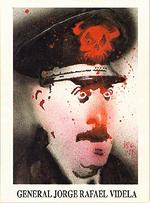 On the heels of their 1989 comic book “Brought to Light: Thirty Years of Drug Smuggling, Arms Deals, & Covert Action,” in 1990 Eclipse published the original Friendly Dictator Trading Cards. The hallucinogenic artwork of Bill Sienkiewicz illustrates “three dozen of America’s most embarrassing ‘friends’, a cunning crew of tyrants and corrupt puppet-presidents who have been rewarded handsomely for their loyalty to U.S. interests.” Other political trading card sets published by Eclipse include “Drug Wars,” “The Iran Contra Scandal,” and “Rotten to the Core - New York Political Scandal,” and “Coup D’etat,” which presents theories pertaining to the assassination of President John F. Kennedy.
On the heels of their 1989 comic book “Brought to Light: Thirty Years of Drug Smuggling, Arms Deals, & Covert Action,” in 1990 Eclipse published the original Friendly Dictator Trading Cards. The hallucinogenic artwork of Bill Sienkiewicz illustrates “three dozen of America’s most embarrassing ‘friends’, a cunning crew of tyrants and corrupt puppet-presidents who have been rewarded handsomely for their loyalty to U.S. interests.” Other political trading card sets published by Eclipse include “Drug Wars,” “The Iran Contra Scandal,” and “Rotten to the Core - New York Political Scandal,” and “Coup D’etat,” which presents theories pertaining to the assassination of President John F. Kennedy.
Douglas Rushkoff’s 1994 book Media Virus quotes journalist and Eclipse editor Catherine Yronwode:
“Our trading cards are designed so they read like Hypercard stacks. Each cross-references to other cards... They all connect, and you can rearrange them in chains of interconnectivity. Or chronologically. You can find out who someone’s boss was, how different people moved around, that this guy was in Vietnam at the same time as this guy, and then that they were both in Nicaragua at the same time, too.”
Eclipse’s “Crime and Punishment” and “True Crime” cards, which present information about serial killers and gangsters, prompted the Board of Supervisors of Nassau County to pass Local Law 11-1992 which made it illegal to disseminate “indecent crime material to minors.” From the Friendly Dictators site:
“In 1997... a U.S. federal appeals court struck down a Nassau County, New York law banning the sale of trading cards depicting ‘any heinous crime". The court found for Eclipse who had challenged the law on First Amendment grounds - cf: Eclipse Enterprises, Inc. v. Gulotta (U.S. Federal Court of Appeal, 2nd Circuit, December 1997). The expense of this court case seems to have bankrupted them - at any rate, for whatever reason, Eclipse appears to have folded. There are no web entries for the company, no listing in any of the Publishing Indexes I’ve been able to find, and all its products are out of print, as far as the big web booksellers are concerned.”
Details of the case and proceedings can be found here.
Lost in Translation
“Much has already been made of the thumbs-up gesture that British and American soldiers have received from ‘welcoming’ Iraqis. Unlike in many western cultures, in the Middle East the thumbs-up can be an insult, roughly translating as ‘up yours’. But the US Army’s Defense Language Institute says that after the first Gulf War, the gesture was adopted by some Iraqis, along with the ok sign, as a ‘symbol of co-operation and freedom’.” (BBC)
Aussie Military Pulls College Ads over Parody
From The Sunday Mail:
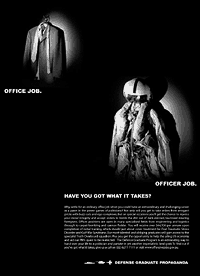 “[Australia’s] Department of Defence appears to have pulled all its advertising from every student newspaper in the country because one Sydney publication made fun of it.
“[Australia’s] Department of Defence appears to have pulled all its advertising from every student newspaper in the country because one Sydney publication made fun of it.
The University of Technology Sydney student newspaper Vertigo ran a satirical ad to counter recruitment advertisements appearing in other publications and voice the editors’ opposition to war on Iraq.
Under the heading, ‘Have you got what it takes?’, the ad reads:
‘Why settle for an ordinary office job when you could have an extraordinary and challenging career as a pawn in the power games of politicians?
‘Not only will you get to take orders from arrogant pricks with buzz-cuts and ego complexes, but on special occasions you’ll get the chance to repress your moral integrity and accept orders to bomb the shit out of dark-skinned, tea towel wearing foreigners.’
Vertigo editor Jano Gibson said that after seeing the ad, the Defence Department pulled all advertising from every student paper in the country.
The move comes at a time when many student newspapers are struggling for financial survival and increasingly reliant upon advertising.
But far from being disappointed, the editors are thrilled that they have eliminated all Defence ads, saying the Government had played right into their hands.
Mr Gibson said Vertigo had already refused ads from the department and was trying to get other student papers to do the same.
‘In effect the Department of Defence has fulfilled our intentions in having a boycott across the rest of Australia,’ he told AAP.
‘We see it as a great victory that students are no longer being inundated with false representations of the defence forces.’”
From the Sydney IndyMedia:
“As an act of solidarity the parody will also be reprinted by Rabelais, the student paper of La Trobe University, and Lot’s Wife, the student publication of Monash University, with more possibly to follow.”
Joe President
Joe Lieberman for President satire site.
Saw this a couple of weeks ago. Had a surprisingly hard time finding it again just now, so decided to link it here.
A faithfully mocking copy of the official site. They really nail the design and chatty tone, though I find the humor a bit obvious and the criticism rather dull. There’s so much more damning information in his voting record alone.
Doh
The Yes Men, corporate trouble makers and designers of the WTO parody site, marked the 18th anniversary of the Bhopal disaster with the launch of Dow-Chemical.com, a straight-faced parody site using the design of the original, and a cheeky press release in the voice of the corpoation. Unfortunately, their cleverness got the best of them and the site was brought down in a matter of days. (Mirror sites are now up.)
 While funny at first, in context the parody Web site feels a bit thin. Sure it’s fun to parody the public relations language used to bathe coroporations in the soft glow of environmental and corporate responsibiliy. But also marking the anniversary were thousands of people marching in the streets of Bhopal.
While funny at first, in context the parody Web site feels a bit thin. Sure it’s fun to parody the public relations language used to bathe coroporations in the soft glow of environmental and corporate responsibiliy. But also marking the anniversary were thousands of people marching in the streets of Bhopal.
An estimated 500,000 people were affected when 40 tons of lethal gases leaked from Union Carbide Corporation’s pesticide factory in Bhopal in 1984. Today, the number of deaths stands at 20,000. Virtually nothing has been done to clean up the site, and the water used by people for everyday needs is still contaminated. And via Reuters:
“Former Union Carbide chairman Warren Anderson faces charges of culpable homicide and Indian courts have repeatedly asked New Delhi to seek his extradition from the United States where he now lives in retirement. Anderson, considered a fugitive from Indian law for refusing to face charges in its courts, could be jailed for 10 years and fined if found guilty.”
So what of design and social change? Well, a bit of design forensics determined that it was a failure of design that led to the disaster. On December 2, New Scientist published an article on their investigation of the accident and recently released documents that identify the reasons for the failure and show that the company that built and owned the Bhopal plant cut crucial corners and safety features from its design of the plant.
“Union Carbide was forced to release the documents last month by a court in New York state that was hearing a class action suit filed by Bhopal survivors in 1999. According to New Scientist, Carbide’s 1972 memo specified that the US headquarters would either perform all design work for the plant, or approve designs done elsewhere. The report said that on the basis of fresh evidence, the US Company could be tried for negligence only if the Indian government joined the campaigners in the US lawsuit.”
...
Further info via rtMark press release:
“Burson-Marsteller, the public relations company that helped to ‘spin’ Bhopal, has meanwhile sued college student Paul Hardwin for putting up a fake Burson-Marsteller site, http://www.bursonmarsteller.com/, which recounted how the PR giant helped to downplay the Bhopal disaster. Burson-Marsteller’s suit against Hardwin will be heard next week by the World Intellectual Property Organization.
Hardwin, unable to afford a lawyer, has composed a dryly humorous 57-page rebuttal to the PR giant’s lawsuit. On page 7, for instance, the student notes that Burson-Marsteller’s stated goal is
‘to ensure that the perceptions which surround our clients and influence their stakeholders are consistent with reality.’
Hardwin goes on to assert that his satirical domain is doing precisely that, by publicizing
‘academic and journalistic materials about Burson-Marsteller’s involvement with and relationship to, for example, Philip Morris and the National Smoker’s Alliance, a consumer front group designed to create the appearance of public support for big-tobacco policies; Union Carbide and the deaths of 20,000 people following the 1984 disaster in Bhopal; and political regimes such as that of Romanian dictator Nicolae Ceausescu and more recently Saudi Arabia following the events of September 11; and to properly associate them with the relevant Trademark so that they may be understood accordingly by Internet users.’
In response to the suit’s claim that ‘a substantial degree of goodwill is associated with [the Burson-Marstellar Trademark]’ Hardwin offers much ‘evidence to the contrary’ including ‘a newspaper headline in which the Complainant is characterized as “the Devil.”’
The primary goal of RTMark is to publicize corporate subversion of the democratic process. Just like other corporations, it achieves its aims by any and all means at its disposal. RTMark has previously helped to publicize websites against political parties, political figures, and entities like the World Trade Organization and the World Economic Forum.
Securing the Homeland through Culture
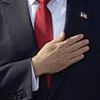 “[The Homeland Security Cultural Bureau] is protecting the interests of the country’s national security by employing efforts to direct and guide the parameters of cultural production.”
“[The Homeland Security Cultural Bureau] is protecting the interests of the country’s national security by employing efforts to direct and guide the parameters of cultural production.”
“Which artists and strategies may be most aligned with the agents of terror? Who are the postmodernists and do they really pose a threat? Again, here we present to you a cogent argument for rethinking our culture and for aligning our needs for security with a new relation to art.”
A very official-looking, straight-faced satire site.
See also http://www.whitehouse.org/ and http://www.gwbush.com, two other satire sites. I found whitehouse.org’s Department of Homeland Security page when searching for the real Department of Homeland Security page.
Enjoy Sara-jevo
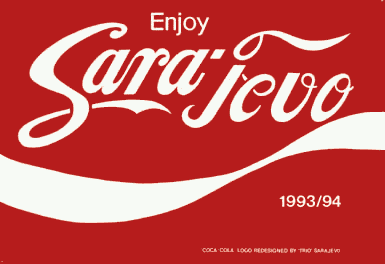
In 1985, three graduates from the Sarajevo faculty of fine arts formed the design team TRIO Sarajevo. The group created designs for bands, theatre companies and art and culture-based magazines.
“In April 1992 the Bosnian war began, and Sarajevo was besieged. Despite the obvious hardships of life in a city under siege for two and a half years, and although they had many opportunities to continue work outside Bosnia-Herzegovina, TRIO opted to remain in Sarajevo throughout the war. Faced with a market suddenly reduced to a 3km wide stretch of a city under siege, TRIO have nonetheless continued to earn a living as commercial designers, receiving payment for their work in food, cigarettes and (occasionally) small amounts of money. During the war TRIO have managed to assemble a computerised design office put together from various components which were borrowed or begged from friends and colleagues in Sarajevo.... In addition to their regular work, TRIO have also invested a great deal of time putting together a collection of graphic art aimed at raising awareness of the plight of their city throughout Europe. The work which has made them famous in western capitals is based on a series of reworkings of well-known advertising and pop-art images, such as the logos for Speilberg’s Jurassic Park, Coca-Cola, Absolut Vodka, Warhol’s famous Campbell’s Soup, and satirical adaptations of famous posters, such as Monroe’s Some Like it Hot, Your Country Needs You, Wake Up America!, Munch’s Scream, and many more.”
From The Design Group - TRIO SARAJEVO. The visual formula is direct and simplistic, but according to “Ironic Postcards from a City at War” the intent is to inject notice of the crisis into Western pop culture, to attach new associations to strongly recognized brands. My favorite is not one that uses the commercial brands, it is the stamp the group designed in 1995 with an image of one of destroyed post office buildings:
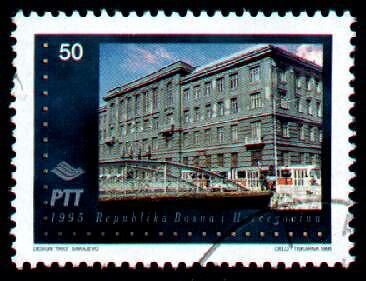
Found via OpenDemocracy



